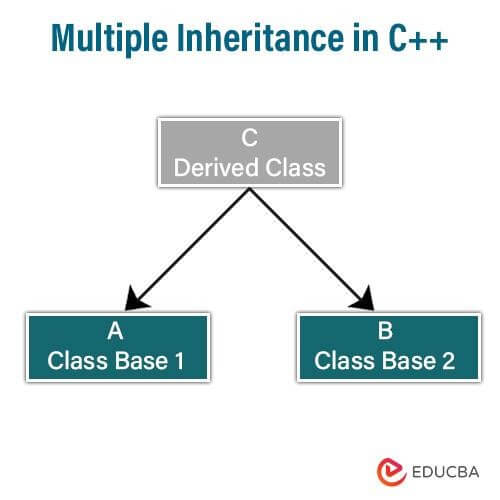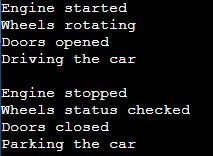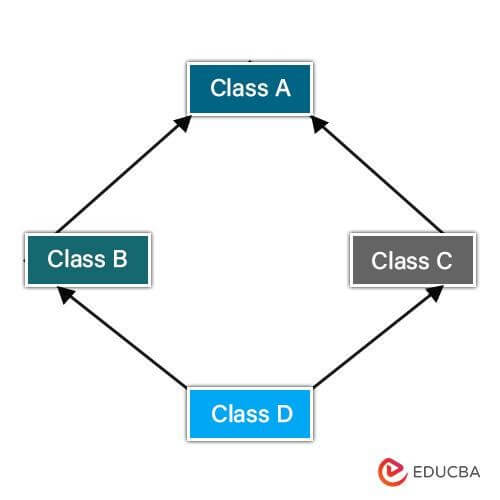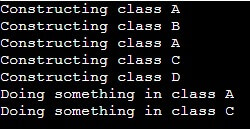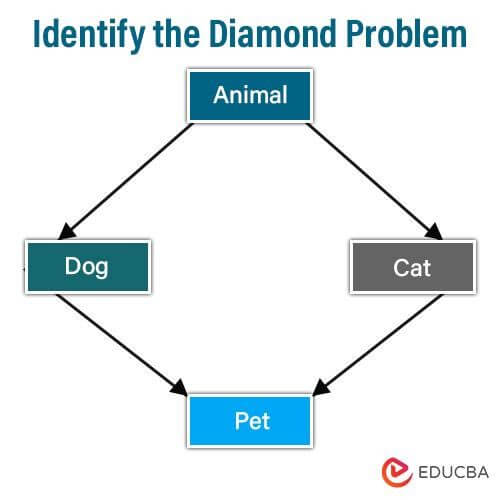Introduction to Diamond Problem in C++
In C++, the “diamond problem” arises in multiple inheritance when a class inherits from two classes that share a common ancestor. This common ancestor is then inherited twice through two paths, forming a diamond-shaped inheritance hierarchy. This situation can create ambiguity in the program, especially if the standard ancestor class contains data members or methods, as it introduces uncertainty about which inherited version to utilize.
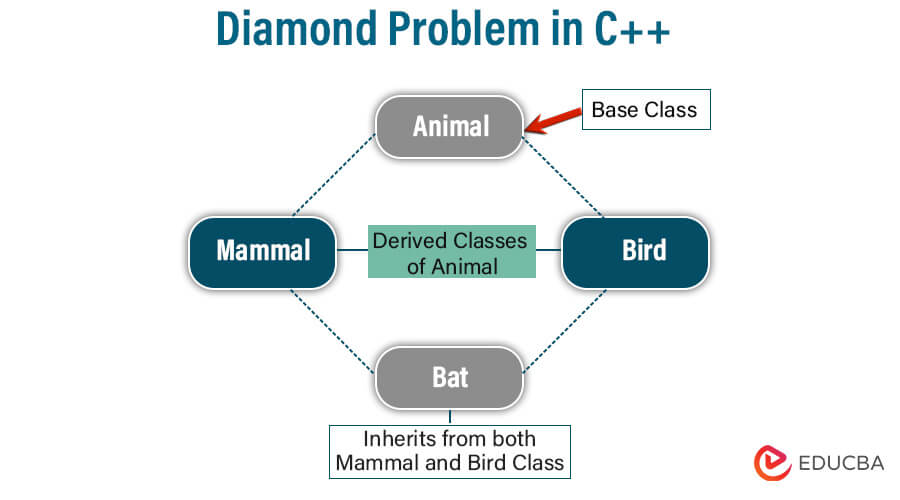
Table of Contents
Key takeaways
- The diamond problem in C++ arises from multiple inheritances.
- Occurs when a class inherits from two classes sharing a common ancestor.
- The common ancestor is inherited twice, leading to ambiguity.
- It can cause compilation errors and unpredictable behavior.
- Techniques to resolve this include virtual inheritance and class hierarchy redesign.
Multiple Inheritances in C++
Multiple inheritance in C++ allows a class to inherit attributes and behaviors from more than one base class. This means a derived class can have multiple parent classes, each contributing its members (methods and attributes) to the derived class.
A derived class can access members from all its base classes with multiple inheritance, providing greater class hierarchy and code reuse flexibility. However, it can also lead to complexities like the diamond problem, where ambiguity may arise if two or more base classes define members with the same name.
The image below illustrates a visual representation of multiple inheritances.
The diagram shows that class C inherits classes A and B.
In real-life situations, children inherit traits from both their fathers and mothers. Therefore, a child can be seen as a derived class with “Father” and “Mother” as its parents. This principle applies in numerous real-life scenarios involving multiple inheritance.
Example of Multiple Inheritances:
We use multiple inheritance to represent various vehicle types in a vehicle manufacturing system. Three base classes are defined: Engine, Wheels, and Body. From these, we derive a Car class that integrates all functionalities. For example, its drive() method initiates the engine, checks wheel status, and closes doors using park() for parking simulation. Multiple inheritance efficiently models diverse vehicle types.
Code
#include
// Base class representing an engine
class Engine {
public:
void start() {
std::cout << "Engine started" << std::endl;
}
void stop() {
std::cout << "Engine stopped" << std::endl;
}
};
// Base class representing wheels
class Wheels {
public:
void rotate() {
std::cout << "Wheels rotating" << std::endl;
}
void checkStatus() {
std::cout << "Wheels status checked" << std::endl;
}
};
// Base class representing the body
class Body {
public:
void openDoors() {
std::cout << "Doors opened" << std::endl;
}
void closeDoors() {
std::cout << "Doors closed" << std::endl;
}
};
// Derived class representing a car, inheriting from Engine, Wheels, and Body
class Car : public Engine, public Wheels, public Body {
public:
void drive() {
start(); // Accessing method from Engine
rotate(); // Accessing method from Wheels
openDoors(); // Accessing method from Body
std::cout << "Driving the car" << std::endl;
}
void park() {
stop(); // Accessing method from Engine
checkStatus(); // Accessing method from Wheels
closeDoors(); // Accessing method from Body
std::cout << "Parking the car" << std::endl;
}
};
int main() {
Car car;
car.drive();
std::cout << std::endl;
car.park();
return 0;
}Output:
Explanation:
- In this scenario, we have three base classes Engine, Wheels, and Body, each representing a distinct vehicle component.
- The Car class inherits from the Engine, Wheels, and Body base classes.
- The Car class inherits the functionalities of starting/stopping the engine, rotating/checking the status of the wheels, and opening/closing the doors.
- Methods like drive() and park() in the Car class demonstrate how methods from all three base classes can be accessed and utilized within the derived class.
The Diamond Problem Explained
The Diamond Problem commonly occurs in object-oriented programming languages, especially those that allow multiple inheritance. It emerges when a class inherits from two or more classes that share a common ancestor, resulting in ambiguity in the inheritance hierarchy.
To illustrate, consider a class hierarchy where Class A is the base class, and Class B and Class C inherit from Class A. If another class, Class D, inherits from Class B and Class C, the inheritance tree forms a diamond shape, leading to the Diamond Problem.
The issue arises due to Class D inheriting attributes and methods from Class B and Class C, which inherit from Class A. This may lead to ambiguity if Class B and C define methods or attributes with the same name.
For instance, if Class A has a method named do_something(), and both Class B and Class C override this method with different implementations, when Class D inherits from both B and C, which do_something() method should it inherit? This ambiguity is the essence of the Diamond Problem.
Code
#include
using namespace std;
// Base class
class A {
public:
A() {
cout << "Constructing class A" << endl;
}
void do_something() {
cout << "Doing something in class A" << endl;
}
};
// Derived class B inheriting from A
class B : public A {
public:
B() {
cout << "Constructing class B" << endl;
}
void do_something_else() {
cout << "Doing something else in class B" << endl;
}
};
// Derived class C inheriting from A
class C : public A {
public:
C() {
cout << "Constructing class C" << endl;
}
void do_something() {
cout << "Doing something in class C" << endl;
}
};
// Derived class D inheriting from both B and C
class D : public B, public C {
public:
D() {
cout << "Constructing class D" << endl;
}
};
int main() {
D d;
d.B::do_something(); // Call do_something() method from class B
d.C::do_something(); // Call do_something() method from class C
return 0;
}Output:
Explanation
In this C++ code, we have four classes: A, B, C, and D. A serves as the base class, while both B and C derive from A. Class D inherits from both B and C, forming a diamond-shaped inheritance structure.
Each class defines a method: do_something(). However, both classes B and C redefine this method, which results in ambiguity when calling do_something() from an instance of class D.
To resolve this ambiguity, we explicitly specify which do_something() method to call by prefixing it with the name of the base class. In the main() function, we demonstrate this by invoking do_something() from both B and C within the instance of class D, ensuring clarity in method resolution and avoiding the Diamond Problem.
Real-Life Example
Let’s consider a scenario where we have a base class called Employee, which contains common attributes and methods for all types of employees. Then, we have two types of specialized employees: Manager and Developer. Another employee type could be a TeamLead, inheriting traits from both Manager and Developer roles, responsible for overseeing both managerial and development tasks. This scenario forms a diamond-shaped inheritance structure.
Here’s how you can represent this scenario in C++:
#include
#include
using namespace std;
// Base class Employee
class Employee {
protected:
string name;
int employeeId;
public:
Employee(const string& name, int employeeId) : name(name), employeeId(employeeId) {}
void display() const {
cout << "Name: " << name << ", Employee ID: " << employeeId << endl;
}
};
// Manager class inheriting from Employee
class Manager : virtual public Employee {
public:
Manager(const string& name, int employeeId) : Employee(name, employeeId) {}
};
// Developer class inheriting from Employee
class Developer : virtual public Employee {
public:
Developer(const string& name, int employeeId) : Employee(name, employeeId) {}
};
// TeamLead class inheriting from both Manager and Developer
class TeamLead : public Developer, public Manager {
public:
TeamLead(const string& name, int employeeId) : Employee(name, employeeId), Manager(name, employeeId), Developer(name, employeeId) {}
};
int main() {
// Creating an instance of TeamLead
TeamLead teamLead("John Doe", 12345);
// Displaying the information of the TeamLead
cout << "Information of Team Lead:" << endl;
teamLead.display();
return 0;
}Output:
Explanation
- Employee is the base class representing common attributes and methods for all employees.
- Manager and Developer are derived classes representing specialized types of employees inheriting from Employee.
- TeamLead inherits from both Manager and Developer, forming a diamond-shaped inheritance structure.
- To prevent the Diamond Problem, both the Manager and Developer classes utilize the virtual keyword when inheriting from the Employee class. This ensures that the Employee is virtually inherited only once in the hierarchy.
- In the main() function, we create an instance of TeamLead, demonstrating the use of a class that inherits from multiple classes, thereby showcasing the Diamond Problem scenario.
In the main() function, an instance of TeamLead is created, demonstrating the use of a class that inherits from multiple classes, thereby showcasing the Diamond Problem scenario.
Solution of Diamond Problem
In C++, the diamond problem arises when a class inherits from two other classes inherited from a standard base class. It creates ambiguity in the inheritance hierarchy. C++ offers a solution to this problem using virtual inheritance.
- Single Base Class Instance: When using virtual inheritance, the ultimate derived class directly inherits the virtual base class, while any intermediate classes virtually inherit the base class. It guarantees that only one shared instance of the virtual base class exists among all derived classes.
- Constructor Responsibility: The responsibility for constructing the virtual base class instance lies with the ultimate derived class in the hierarchy. It is accountable for initializing the virtual base class.
- Direct Access: Derived classes can access members of the virtual base class directly without ambiguity, as only one instance of the virtual base class exists in the object’s memory layout.
Code
#include
using namespace std;
class Animal {
public:
void breathe() {
cout << "Animal is breathing" << endl;
}
};
class LandAnimal : virtual public Animal {
public:
void walk() {
cout << "LandAnimal is walking" << endl;
}
};
class SeaAnimal : virtual public Animal {
public:
void swim() {
cout << "SeaAnimal is swimming" << endl;
}
};
class Amphibian : public LandAnimal, public SeaAnimal {
public:
void move() {
walk(); // Can call methods from both LandAnimal and SeaAnimal
swim();
}
};
int main() {
Amphibian frog;
frog.move();
frog.breathe(); // Since Animal is virtually inherited, there's no ambiguity
return 0;
}Output:
Explanation
- The Animal class serves as the virtual base class for LandAnimal and SeaAnimal, with both inheriting from it.
- Amphibian class inherits from both LandAnimal and SeaAnimal.
- Only one instance of Animal is shared among LandAnimal, SeaAnimal, and Amphibian.
- This prevents ambiguity in the hierarchy and allows Amphibian to access Animal methods without ambiguity.
Identifying the Diamond Problem
The diamond problem, sometimes called the “deadly diamond of death,” is a challenge that arises in scenarios involving multiple inheritance, notably in object-oriented programming languages such as C++ and Java. It happens when two classes with a shared ancestor are inherited by one class. This leads to ambiguity in the inheritance hierarchy, which can result in various issues such as:
- Ambiguous Method Resolution: If both parent classes implement the same method, it becomes unclear which implementation the derived class should inherit.
- Data Redundancy: If the standard ancestor class contains data members, inheriting from both parent classes can lead to redundant copies of data in the derived class.
- Construction Ambiguity: In languages like C++, where constructors are not inherited, it becomes unclear which constructor(s) should be called during object instantiation.
- Access Ambiguity: Accessing members inherited from the common ancestor may need clarification, leading to compilation errors or unexpected behavior.
Here’s an illustration:
In this example, a Pet inherits from both a Dog and a Cat, which share a common ancestor Animal. If both Dog and Cat define a method called makeSound(), it becomes unclear which implementation Pet should inherit. It is the diamond problem.
Comparison with Other Languages
| Section | C++ | Java | Python |
| Multiple Inheritance Support | Supports multiple inheritance of classes. | Supports multiple inheritance of interfaces. | Supports multiple inheritance of classes. |
| Diamond Problem | Occurs when a class inherits from two classes inherited from a common base class. | Not applicable because Java doesn’t allow multiple inheritance of classes. | Occurs similarly to C++ when a class inherits from two classes that both inherit from a common base class. |
| Solution | Resolved using virtual inheritance. | Not applicable. | Resolved using the C3 linearization algorithm for method resolution order (MRO). |
| Mechanism | Virtual inheritance ensures a single instance of the shared base class. | Interfaces facilitate multiple inheritance without causing the diamond problem. | The C3 linearization algorithm calculates MRO to determine method resolution order, avoiding ambiguity. |
| Inheritance | Classes can inherit from multiple base classes. | Classes can implement multiple interfaces. | Classes can inherit from multiple base classes. |
| Composition | Encourages composition over inheritance. | Encouraged approach for code reuse and flexibility. | Encouraged approach for code clarity and maintainability. |
| Example Language Features | C++ Standard Library, Boost libraries. | Java Standard Edition libraries. | Python Standard Library, third-party libraries. |
Conclusion
In C++, the diamond problem emerges from multiple inheritance, when a class inherits from two classes that share a common base class. This scenario introduces ambiguity in method resolution and potential data redundancy. To address this, virtual inheritance ensures a single instance of the shared base class, resolving ambiguity and promoting efficient code organization.
Frequently Asked Questions (FAQs)
Q1. Are there alternative approaches to virtual inheritance for resolving the diamond problem in C++?
Answer: Although the main method for tackling the diamond problem in C++ is virtual inheritance, other design patterns, including composition over inheritance or redesigning the class hierarchy, might also be taken into account, depending on the particular needs of the application.
Q2. Are there any performance implications of using virtual inheritance to resolve the diamond problem?
Answer: Virtual inheritance helps alleviate the diamond problem, but because managing the virtual base class requires additional accounting, there may be a modest speed and memory overhead. However, in the majority of cases, the effect is usually insignificant.
Q3. Are any tools or techniques available to detect and prevent the diamond problem in C++ code?
Answer: Certain C++ code analysis tools and static analyzers can identify possible occurrences of the diamond problem and offer recommendations or cautions for fixing it. Moreover, early in the development process, code reviews and adherence to best practices can aid in identifying and mitigating problems associated with the diamond problem.
Q4. Are there any limitations or drawbacks to using virtual inheritance in C++?
Answer: Although virtual inheritance can alleviate the diamond problem, it might complicate things and put more mental strain on engineers. Furthermore, cautious thought may be needed to guarantee correct initialization and prevent unforeseen outcomes like slicing.
